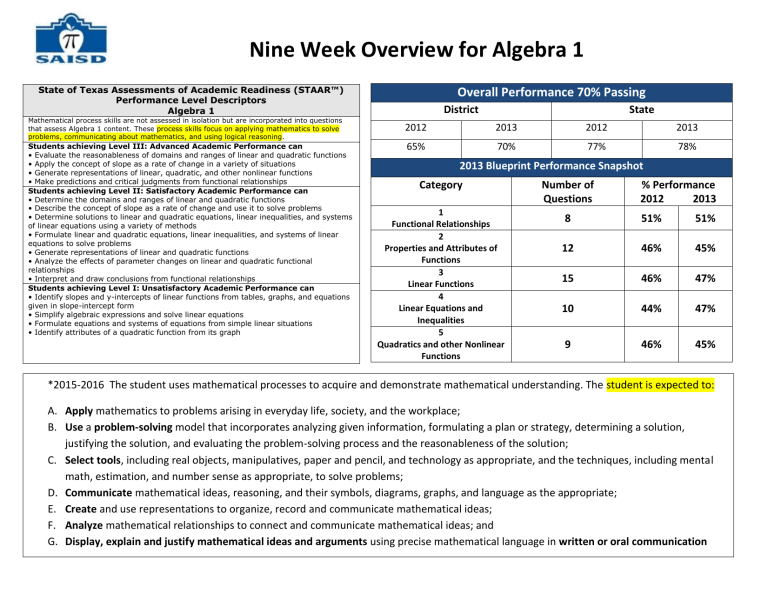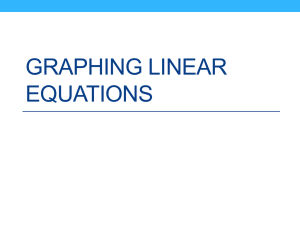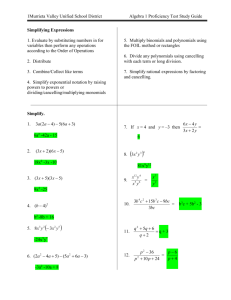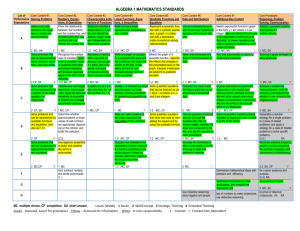2nd Nine weeks Overview

Nine Week Overview for Algebra 1
State of Texas Assessments of Academic Readiness (STAAR™)
Performance Level Descriptors
Algebra 1
Mathematical process skills are not assessed in isolation but are incorporated into questions that assess Algebra 1 content. These process skills focus on applying mathematics to solve problems, communicating about mathematics, and using logical reasoning.
Students achieving Level III: Advanced Academic Performance can
• Evaluate the reasonableness of domains and ranges of linear and quadratic functions
• Apply the concept of slope as a rate of change in a variety of situations
• Generate representations of linear, quadratic, and other nonlinear functions
• Make predictions and critical judgments from functional relationships
Students achieving Level II: Satisfactory Academic Performance can
• Determine the domains and ranges of linear and quadratic functions
• Describe the concept of slope as a rate of change and use it to solve problems
• Determine solutions to linear and quadratic equations, linear inequalities, and systems of linear equations using a variety of methods
• Formulate linear and quadratic equations, linear inequalities, and systems of linear equations to solve problems
• Generate representations of linear and quadratic functions
• Analyze the effects of parameter changes on linear and quadratic functional relationships
• Interpret and draw conclusions from functional relationships
Students achieving Level I: Unsatisfactory Academic Performance can
• Identify slopes and y-intercepts of linear functions from tables, graphs, and equations given in slope-intercept form
• Simplify algebraic expressions and solve linear equations
• Formulate equations and systems of equations from simple linear situations
• Identify attributes of a quadratic function from its graph
2012
65%
Overall Performance 70% Passing
District
Category
2013
70%
2012
77%
State
2013 Blueprint Performance Snapshot
1
Functional Relationships
2
Properties and Attributes of
Functions
3
Linear Functions
4
Linear Equations and
Inequalities
5
Quadratics and other Nonlinear
Functions
Number of
Questions
8
12
15
10
9
% Performance
2012 2013
51%
46%
46%
44%
46%
2013
78%
51%
45%
47%
47%
45%
*2015-2016 The student uses mathematical processes to acquire and demonstrate mathematical understanding. The student is expected to:
A.
Apply mathematics to problems arising in everyday life, society, and the workplace;
B.
Use a problem-solving model that incorporates analyzing given information, formulating a plan or strategy, determining a solution, justifying the solution, and evaluating the problem-solving process and the reasonableness of the solution;
C.
Select tools, including real objects, manipulatives, paper and pencil, and technology as appropriate, and the techniques, including mental math, estimation, and number sense as appropriate, to solve problems;
D.
Communicate mathematical ideas, reasoning, and their symbols, diagrams, graphs, and language as the appropriate;
E.
Create and use representations to organize, record and communicate mathematical ideas;
F.
Analyze mathematical relationships to connect and communicate mathematical ideas; and
G.
Display, explain and justify mathematical ideas and arguments using precise mathematical language in written or oral communication
Pacing
Week 1
Week 2
A.5B
A.6B
A.6E
A.7C
A.2C
A.6A
A.6B
A.6C
TEK
A.2B
A.5C
A.6E
A.6F
A.6G
% Pass
62%
34%
48%
57%
44%
69%
25%
49%
34%
42%
36%
NA
NA
49%
34%
43%
47%
56%
42%
37%
57%
49%
44%
Nine Week Overview for Algebra 1
Nine Week at A-Glance
Description identify mathematical domains and ranges and determine reasonable domain and range values for given situations, both continuous and
discrete use, translate, and make connections among algebraic, tabular, graphical,
or verbal descriptions of linear functions
Vocabulary
Quadrants (1-IV)
Coordinate plane
Ordered Pair
Standard Form Linear Equation
Linear Function x- intercept y-intercept
determine the domain and range for linear functions in given situations interpret the meaning of slope and intercepts in situations using data,
symbolic representations, or graphs determine the intercepts of the graphs of linear functions and zeros of linear functions from graphs, tables, and algebraic representations interpret and determine the reasonableness of solutions to linear
equations and inequalities interpret situations in terms of given graphs or creates situations that fit
given graphs develop the concept of slope as rate of change and determine slopes
from graphs, tables, and algebraic representations interpret the meaning of slope and intercepts in situations using data,
symbolic representations, or graphs investigate, describe, and predict the effects of changes in m and b on the
graph of y = mx + b
Slope
Rate of change
y
x
Slope-intercept form
Parallel
Direct Variation
Constant of Variation
Function notation
Family of functions
Parent function determine the intercepts of the graphs of linear functions and zeros of linear functions from graphs, tables, and algebraic representations interpret and predict the effects of changing slope and y-intercept in
applied situations relate direct variation to linear functions and solve problems involving
proportional change
Week 3
A.2A
A.4C
A.2A
A.4C
A.6C
A.6F
A.1C
A.5C
Week 4
A.6D
A.7A
A.1C
A.4C
A.6D
A.6F
A.7A
64%
52%
34%
45%
37%
57%
49%
64%
43%
47%
56%
37%
57%
49%
52%
57%
44%
69%
45%
31%
34%
31%
34%
Nine Week Overview for Algebra 1 identify and sketch the general forms of linear (y = x) and quadratic (y = x 2 ) parent functions
Connect equation notation with function notation, such as y=x + 1 and f(x) = x + 1 identify and sketch the general forms of linear (y = x) and quadratic (y = x 2 ) parent functions
Connect equation notation with function notation, such as y=x + 1 and
f(x) = x + 1 investigate, describe, and predict the effects of changes in m and b on the
graph of y = mx + b y-intercept slope slope-intercept form interpret and predict the effects of changing slope and y-intercept in
applied situations describe functional relationships for given problem situations and write equations or inequalities to answer questions arising from the situations
Use, translate, and make connections among algebraic, tabular, graphical, or verbal descriptions of linear functions graph and write equations of lines given characteristics such as two
points, a point and a slope, or a slope and y-intercept analyze situations involving linear functions and formulate linear
equations or inequalities to solve problems describe functional relationships for given problem situations and write
equations or inequalities to answer questions arising from the situations
Connect equation notation with function notation, such as y=x + 1 and
f(x) = x + 1 graph and write equations of lines given characteristics such as two
points, a point and a slope, or a slope and y-intercept interpret and predict the effects of changing slope and y-intercept in
applied situations y-intercept slope slope-intercept form
Point-slope form
Standard form analyze situations involving linear functions and formulate linear
equations or inequalities to solve problems
A.5A
A.5C
A.1D
Week 5
A.1E
A.6C
A.6D
A.1E
A.2B
A.2D
Week 6
A.5A
A.1B
A.6E
A.7A
46%
51%
62%
34%
48%
67%
34%
NA
57%
44%
69%
76%
60%
49%
46%
51%
43%
47%
56%
45%
NA
32%
42%
64%
Nine Week Overview for Algebra 1 determine whether or not given situations can be represented by linear functions
Use, translate, and make connections among algebraic, tabular,
graphical, or verbal descriptions of linear functions represent relationships among quantities using concrete models, tables, graphs, diagrams, verbal descriptions, equations, and inequalities interpret and make decisions, predictions, and critical judgments from functional relationships investigate, describe, and predict the effects of changes in m and b on the
graph of y = mx + b graph and write equations of lines given characteristics such as two points, a point and a slope, or a slope and y-intercept interpret and make decisions, predictions, and critical judgments from
functional relationships identify mathematical domains and ranges and determine reasonable domain and range values for given situations, both continuous and
discrete collect and organize data, make and interpret scatterplots (including recognizing positive, negative, or no correlation for data approximating linear situations), and model, predict, and make decisions and critical
judgments in problem situations. determine whether or not given situations can be represented by linear functions gather and record data and use data sets to determine functional relationships between quantities determine the intercepts of the graphs of linear functions and zeros of
linear functions from graphs, tables, and algebraic representations analyze situations involving linear functions and formulate linear equations or inequalities to solve problems
Parallel lines
Perpendicular lines
Converse
Scatter plot
Correlation
Line of fit
Positive correlation
Negative correlation
No correlation
Best fitting line
Linear regression
Zero of a function
Inequality
One-Variable Inequalities
Week 7
A.1E
A.8A
A.8B
Week 8
A.8C
A.8A
A.8B
A.7B
A.7C
A.1C
A.1D
Week 9
A.8C
A.8A
A.8B
A.8C
50%
44%
37%
51%
46%
50%
44%
37%
51%
50%
44%
37%
51%
46%
75%
19%
44%
36%
52%
76%
60%
49%
46%
51%
46%
Nine Week Overview for Algebra 1 investigate methods for solving linear equations and inequalities using concrete models, graphs, and the properties of equality, select a method, and solve the equations and inequalities interpret and determine the reasonableness of solutions to linear equations and inequalities describe functional relationships for given problem situations and write equations or inequalities to answer questions arising from the situations represent relationships among quantities using concrete models, tables,
graphs, diagrams, verbal descriptions, equations, and inequalities
Solution of an inequality
Linear inequalities interpret and make decisions, predictions, and critical judgments from functional relationships analyze situations and formulate systems of linear equations in two
unknowns to solve problems solve systems of linear equations using concrete models, graphs, tables,
and algebraic methods
Formulate
System of equations
Solution of a system of linear equations
Inconsistent system
Consistent Dependent system interpret and determine the reasonableness of solutions to systems of
linear equations analyze situations and formulate systems of linear equations in two
unknowns to solve problems solve systems of linear equations using concrete models, graphs, tables,
and algebraic methods
Formulate
System of equations
Solution of a system of linear equations
Inconsistent system
Consistent Dependent system interpret and determine the reasonableness of solutions to systems of
linear equations analyze situations and formulate systems of linear equations in two
unknowns to solve problems solve systems of linear equations using concrete models, graphs, tables,
and algebraic methods
Formulate
System of equations
Solution of a system of linear equations
Inconsistent system
Consistent Dependent system
System of linear inequalities interpret and determine the reasonableness of solutions to systems of
linear equations
A.1D
A.1E
76%
60%
49%
46%
51%
Nine Week Overview for Algebra 1 represent relationships among quantities using concrete models, tables,
graphs, diagrams, verbal descriptions, equations, and inequalities interpret and make decisions, predictions, and critical judgments from
functional relationships
TEKS Deconstruction
Nine Week Overview for Algebra 1
Algebra I Section 4.7 Graph Linear Functions Days 10-11
TEK A.6(F) Interpret and predict the effects of changing slope and y-intercept in applied situations;
Readiness Standard
Effects of changing Slope
Interpret
Effects of changing
Y-intercept
Effects of changing Slope
Predict
Effects of changing
Y-intercept
Nine Week Overview for Algebra 1
A Closer Look at the TEKS: STAAR 2013 Release Items by TEKS
IQ Analysis │ Investigating the Question SE A.6F RC 3
TEK A.6(F) Interpret and predict the effects of changing slope and y-intercept in applied situations;
Analysis A.6F
14. Students at a school will sell hats to raise money. There are some hats left over from last year, and 20 boxes of hats will be ordered this year. When the order arrives, the total number of hats the students will have can be determined using the function f(x) = 48x + 37, where
x represents the number of boxes ordered. If the number of hats per box changes so that the situation is modeled by the function h(x) =
24x + 37, then how many fewer hats will the students have available to sell if they still order 20 boxes?
Record your answer and fill in the bubbles on your answer document.
Type
Data
Process Standard
A/F
%
B/G
C/H
D/J
Units:
Readiness
Error Type
Procedural
Application
Conceptual
Supporting
Guessing
Taught v. Learned Similar to examples (taught)
Requires application (learned)
Question Level
(Depth of
Knowledge)
Level 1
Level 2
Level 3
Level 4
37% Correct (A) Mode is B
What do students need to know to be able to solve this problem?
Nine Week Overview for Algebra 1
A Closer Look at the TEKS: STAAR 2013 Release Items by TEKS
IQ Analysis │ Investigating the Question SE A.6F RC 3
TEK A.6(F) Interpret and predict the effects of changing slope and y-intercept in applied situations;
A.6F Analysis
24. An airplane’s altitude in feet during its descent for landing can be found using the function f(x) = −300x + 30,000, where x represents the horizontal distance in miles from where the plane begins its descent. After new government regulations become law, the airplane’s descent will be modeled by the function
g(x) = −300x + 30,500. Which statement describes this change?
F The airplane starts its descent from an altitude 500 feet higher.
G The airplane starts its descent from an altitude 500 feet lower.
H The airplane descends 500 feet per horizontal mile faster.
J The airplane descends 500 feet per horizontal mile slower.
Units:
Type
Data
Process Standard
A/F
%
B/G
C/H
D/J
Readiness
Error Type
Procedural
Application
Conceptual
Supporting
Guessing
Taught v. Learned Similar to examples (taught)
Requires application (learned)
Question Level
(Depth of
Knowledge)
Level 1
Level 2
Level 3
Level 4
57% answered correctly(H) Mode is F
What do students need to know to be able to solve this problem?
Nine Week Overview for Algebra 1
A Closer Look at the TEKS: STAAR 2013 Release Items by TEKS
IQ Analysis │ Investigating the Question SE A.6F RC 3
TEK A.6(F) Interpret and predict the effects of changing slope and y-intercept in applied situations;
Analysis A.6F
44 The graph below shows the water level in a tank being drained at a constant rate.
If the rate at which the tank is drained is changed to 3 inches per hour and the initial water level stays the same, how would the time it takes to empty the tank be affected?
F It would take 4 fewer hours.
G It would take 1.5 more hours.
H It would take 2 fewer hours.
J It would take 2 more hours.
Type
Data
Process Standard
A/F
%
B/G
C/H
D/J
Units:
Readiness
Error Type
Procedural
Application
Conceptual
Supporting
Guessing
Taught v. Learned Similar to examples (taught)
Requires application (learned)
Question Level
(Depth of
Knowledge)
Level 1
Level 2
Level 3
Level 4
49% answered correctly(H) Mode is J
What do students need to know to be able to solve this problem?








